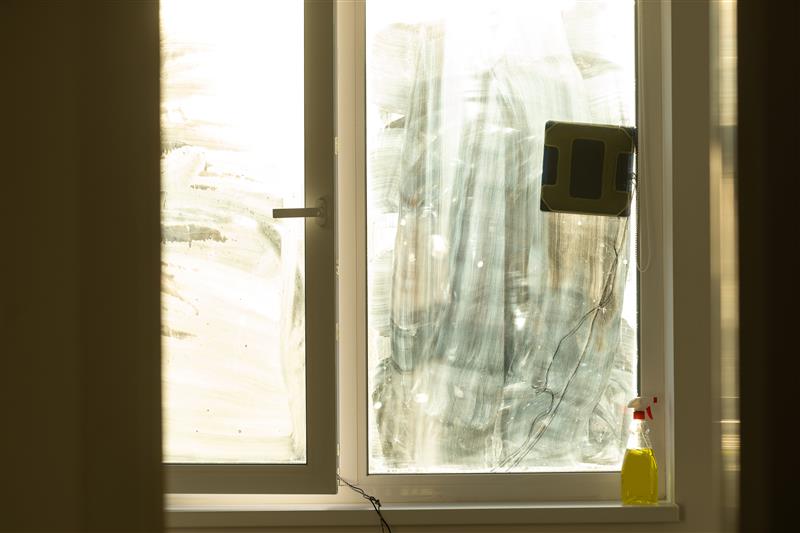
Cleaning glass is only half the battle. The real challenge is keeping it that way. Dust settles. Smudges reappear. And all too often, mirrors and windows lose their clarity just days after a deep clean.
The good news? With the proper habits and tools, you can maintain that fresh, clean look and reduce the frequency of re-cleaning.
This guide covers simple ways to prevent buildup between cleanings, including how the right cleaning formula can help glass resist dust and stay clearer, longer.
Why Glass Gets Dirty So Quickly
Glass may look smooth, but it naturally attracts dust and fingerprints. Static electricity and tiny surface imperfections give particles something to cling to.
Touching mirrors, glass doors, or tabletops leaves behind skin oils that create visible smudges. Meanwhile, airborne particles like pollen, pet dander, and household dust constantly settle, especially near vents or high-traffic areas.
Environmental conditions make it worse:
● HVAC systems stir up fine dust.
● Cooking vapors can coat nearby windows.
● Humid air helps particles stick faster.
When you understand what causes the buildup, it becomes easier to prevent. With the right routine, your glass can stay clearer between cleanings.
Start with a Residue-Free Glass Cleaner
To keep your glass clean for longer, start with a proper base. That means using a glass cleaner that removes dirt and oil without leaving anything behind.
Many multipurpose cleaners contain soaps, scents, or dyes that leave a thin film on the surface. Even if the glass looks clean, that invisible residue attracts dust and fingerprints almost immediately.
A residue-free formula makes a difference. It breaks down oils, lifts away buildup, and evaporates cleanly, leaving nothing behind to attract dust. Invisible Glass fits that bill. It’s ammonia-free, dye-free, and designed to leave glass surfaces truly bare and clear.
When you use Invisible Glass, the surface remains clear, free from sticky films, streaks, and fast-recurring dust. That clarity lasts longer, which means fewer touch-ups and less frequent upkeep.
Use Microfiber Towels to Minimize Static and Smudges
Drying glass properly is just as important as choosing the right cleaner. Paper towels and cotton rags often leave behind lint or streaks. Some can even create fine scratches or static, which attracts dust back to the surface.
Microfiber towels offer a better option. Their ultra-fine fibers lift oils and particles without scratching, and they help dissipate static instead of building it. That means fewer smudges and less dust settling on freshly wiped glass.
To get the best results:
- Always use a clean, dry microfiber towel for buffing
- Skip the fabric softener—residue from softeners can transfer to the glass, causing streaking.
The Best (and Worst) Towels for Streak-Free Glass
| Towel Type |
Effect on Clarity |
Dust Attraction |
Surface Safety |
Best Use |
|---|---|---|---|---|
| ✅Microfiber Towel |
Excellent: Lint-free, streak-free |
Low: Reduces static buildup |
Safe: Non-abrasive |
Use with confidence: Drying, buffing, and polishing glass |
|
❌Paper Towel |
Moderate: May leave lint |
High: Creates static |
Moderate: Can scratch |
Quick touch-ups: Use with care and only for spot touch-up |
|
⚠️Cotton Cloth |
Fair: May smear oils |
Moderate: Can hold static |
Varies: Depends on how coarse the weave is |
General household cleaning: Not preferred for glass |
| ⚠️Newspaper |
Good: Traditional trick |
Low: Non-static |
Relatively safe: May transfer ink or leave lint |
Emergency backup: Use with care |
High-quality microfiber towels help preserve a streak-free finish and keep dust from returning too quickly.
Build Habits That Keep Glass Cleaner Longer
Fingerprints, smudges, and nose prints show up fast when glass gets touched throughout the day. Reducing direct contact helps your glass stay clear between cleanings.
A few habit tweaks can go a long way:
● Use door handles instead of pushing on glass panels.
● Add coasters or placemats to glass tables.
● Keep a microfiber towel near mirrors for quick spot wipes.
● For pet owners, limit access to low windows or sliding doors where noses and paws tend to land.
Small shifts like these make a big difference over time. The less contact your glass gets, the longer it stays visibly clean.
Dust Often—and Use a Gentle Touch
Dust never stops settling, but regular, light dusting keeps it from building up or becoming harder to remove. Wipe glass surfaces weekly with a dry microfiber towel to catch fine dust before it sticks. This routine helps prevent scratches caused by rubbing debris into the glass during deeper cleanings.
In moisture-prone areas, such as bathrooms and kitchens, dust can mix with steam or oils to form cloudy films. For quick touch-ups, use pre-moistened glass wipes made for streak-free results. Invisible Glass Home Glass Cleaning Wipes are a safe, convenient choice; they are easy to keep on hand and are designed to leave no residue behind.
Control the Environment Around Your Glass
Sometimes it’s not fingerprints or dust—it’s the air itself that makes glass dirty. Cooking vapors, candle soot, fireplace smoke, and aerosol sprays can leave behind a fine film that dulls shine and pulls in more dust.
To help protect your glass:
● Use kitchen vents while cooking.
● Choose clean-burning candles and avoid spraying aerosols near glass.
● Replace your HVAC filters regularly to reduce the circulation of particles.
● Close windows on windy days when pollen or dust is high.
Cleaner air means less buildup. When you manage the environment, your glass stays clearer, longer
Keep Glass Clearer, Longer—with Less Effort
Keeping glass spotless doesn’t require daily deep cleaning. It just takes the right tools and a few good habits.
Start with a professional-strength, residue-free glass cleaner like Invisible Glass to eliminate oils without leaving behind film. Use microfiber towels to reduce static and streaks. Limit direct contact, dust gently, and manage indoor air quality to slow the return of dirt.
A few smart habits can keep your glass looking clear and polished day after day. Glass that stays clean makes everything around it feel brighter!



